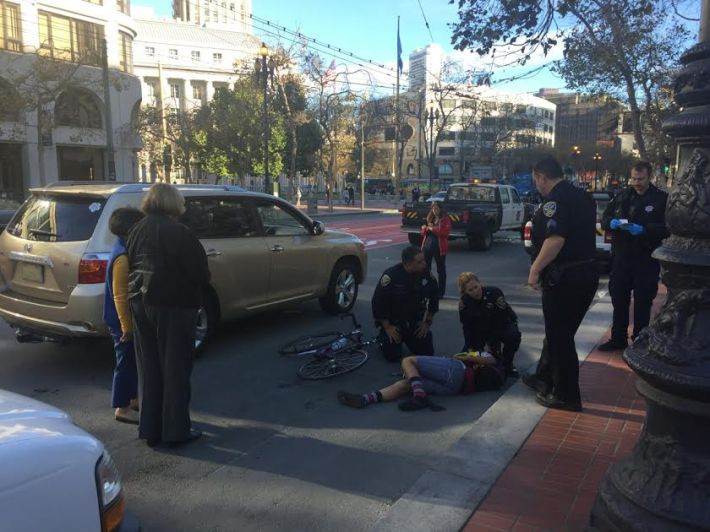
Another cyclist was hit this morning on Market Street, between 7th and 8th, reported Streetsblog reader John Rogers. Details are still coming in. "Market is still a full-on traffic free-for-all, and the danger faced by the thousands of cyclists that ride the central street of our city everyday remains a travesty," he wrote to Streetsblog in an email this afternoon.
Meanwhile, on Tuesday, Director Barbara Garcia of the San Francisco Department of Public Health reported on a recent analysis of trauma patients in the city.
From the Department Director's statement:
People injured in traffic collisions comprise 50 percent of the patients seen at Zuckerberg San Francisco General Trauma Center--exceeding all other categories for cause of injury including falls, cuts/pierces, firearms, and assault
In other words, SF streets are literally a public health menace, like diabetes or guns. "This analysis puts into perspective the pervasiveness of traffic crashes in our society and the urgent need to invest in proven strategies to prevent crashes," was the response of Nicole Ferrara, Executive Director of Walk San Francisco.
The report is part of the Vision Zero initiative to treat traffic injuries as a public health issue that can be solved by better speed enforcement, education and, perhaps most importantly, re-engineering San Francisco's streets to prioritize safety, instead of automobile throughput and ample street parking.
Unfortunately, the past couple of weeks have confirmed the results of the study, through yet another spate of violence on our streets. On Monday, a cyclist was hit at Divisadero and Geary. A week ago it was Valencia.
Frankly, it's getting hard to keep up with the grim news.

Earlier this week, Streetsblog spoke with tipster Lauren Nazario, who saw the aftermath of the crash on Valencia, between 22nd and 23rd. Streetsblog is still trying to sort out the details of that crash, but allegedly an Uber driver illegally entered the bike lane and hit the cyclist (considering how commonplace that is, it's strange to use the convention "allegedly"). It's particularly troubling that this crash happened on the same street where the SFMTA pulled out unofficially installed safe-hit posts a day or two before.
Streetsblog reader Rich Behrens shared an email he wrote to SFMTA about the carnage. An excerpt from his email:
...our streets have become more dangerous than ever: with 20 traffic fatalities in the first eight months of 2016, and at least 5 people hit each day on our streets, we’re on track for the worst year in a long time. I was hit personally in a bike lane on Arguello at California on 6 October. This was in broad daylight and due to an inattentive motorist. This is unacceptable!
Behrens demanded to know when the safe hit posts, installed by the guerrilla group SFMTrA, and subsequently removed by SFMTA, will be replaced near Folsom and Division, which is part of his commute. "Why are you prioritizing removal of effective safety infrastructure and lagging on putting it in?" he wrote.
You can read SFMTA director Ed Reiskin's full reply here. The letter is nearly identical to a piece from SFMTA's blog.
"In 2010, San Francisco had zero miles of protected bike lanes and buffered bike lanes in San Francisco," wrote Reiskin. "Since then, the SFMTA has installed 27 miles of bike lanes that are either protected from traffic by things like parked cars or curbs, or have a space buffer between them and vehicles so people on bikes are safer."
This is a claim that Streetsblog has flagged before. SFMTA has installed 13 miles of protected bike lanes. Reiskin is lumping "protected" bike lanes (meaning lanes with some degree of actual safety) with lanes that are just painted stripes.
In a city with some 1,000 miles of streets, SFMTA has installed 13 miles of protected bike lanes in the past six years. That's by an agency with 4,800 employees, an operating budget of $861 million, and a capital budget of $525 million. Keep in mind no-frills protected bike lanes can be set up with something as inexpensive as planters, or blocks, or, yes, safe-hit posts.
Why does SFMTA prioritize removing unofficial safe-hit posts over installing more bike lanes? According to the letter from the director, "The risk of installing non-approved street designs, whether or not they’re considered safe informally, is that the city may be opened up to lawsuits--the costs of which divert funds from the safety improvements we’re trying to make."
Got that?
"I have never heard of a city that was sued over a cone or soft-hit post. There are a lot of injury lawsuits brought against cities, but they are almost all related to maintenance issues like uplifted sidewalks or potholes," said Robert Prinz, Education Director for Bike East Bay. "People paint the curbs red by their driveways all the time to help prevent them from getting blocked and delivery drivers put cones in the street to protect their illegally parked vehicles from being rear ended. If the city is not taking similar swift action on things like this then their concern about cones and posts rings a bit hollow."
Even if lawsuits were the concern, a Streetsblog contact with years of experience in the City Attorney's office put it this way: sometimes you have to look at the probabilities and take a chance with a lawsuit. Because when people are getting hurt and killed, fear of lawsuits is no excuse for inaction.
"Threading my way between the sides of gridlocked Muni buses and the rail tracks, dodging Uber cars disgorging customers in the middle of the street, weaving in and out of cars, taxis, buses, and trucks, it’s an abomination," wrote Rogers to Streetsblog. "No one should be forced to take such risks just to get to work...how long are we supposed to put up with this?"




